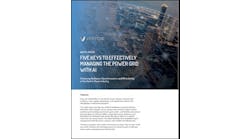By Elisa Wood
No one much likes hearing their industry may be in a bubble. Bubbles burst and it hurts. We’re seeing that now in housing.
So it’s understandable that clean energy companies aren’t exactly happy that economist Eric Janszen (itulip.com) says their industry may experience the next bubble. Apparently, clean energy is exhibiting bubble-like symptoms: It is the talk of the town, attracts investors looking to make quick money, and enjoys strong government support.
But how about energy efficiency? Is it part of this clean energy bubble? I’d argue that it is not.
Demand for energy efficiency is real, not artificially stimulated by government. People are using more computers, air conditioners, energy hungry televisions, chargers and other such devices, thanks to our growing digital economy. These devices create the need for more power. The demand drives up electricity prices. Consumers want to keep using more electricity, and they don’t want to pay more for it. The market is demanding this product we call efficiency to drive down costs.
Consider a news release issued Feb. 13 by Con Edison, which says New York’s energy use has reached unprecedented levels. The utility’s customers used 62,591 gigawatt hours last year, up 23% in ten years.
What’s driving the increased use? Over the last five years, the number of home computers in Con Edison’s service area grew by 600,000; 77% of households now have a home computer. Another half million are projected to be connected in the next five years, says the utility.
Last summer, Con Edison’s customers used six million air conditioners to cool homes and offices; 90% of households now have air conditioning. The utility also sees a significant increase in energy use from flat screen TVs, which use three times as much power as traditional sets.
As prices for these items fall, it’s likely consumers will buy more of them, causing even greater demand for power, and putting more pressure on price. Even with fluctuations in the economy and increasing conservation efforts, Con Edison believes peak electricity use will increase by 10% over the next decade.
Part of the problem is that we have neglected energy efficiency for a long time. It wasn’t important to us in the last decade when electricity prices were low. Now the energy industry is trying to quickly make up for lost time by ramping up efficiency programs.
The efficiency sector is not bubbling; it is filling a vacuum created from years of neglect. At least that’s what I think. Anyone out there want to burst my bubble?
Visit energy writer Elisa Wood and pick up her free Energy Efficiency Markets Newsletter by visiting www.realenergywriters.com





